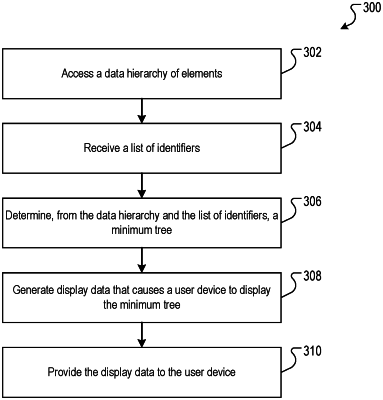| CPC G06F 16/2246 (2019.01) [G06F 16/2365 (2019.01); G06F 16/282 (2019.01)] | 17 Claims |

|
1. A method performed by data processing apparatus, the method comprising:
accessing a data hierarchy of elements, the elements including:
a root element that does not descend from another element;
a plurality of intermediate elements, wherein each intermediate element descends directly from the root element or descends from another intermediate element; and
a plurality of leaf elements, wherein each leaf element descends directly from an intermediate element or descends directly from the root element, and from which no other elements descend;
receiving a list of identifiers, each identifier identifying an element in the data hierarchy as an identified element;
determining, from the data hierarchy and the list of identifiers, a minimum tree that includes:
each of the identified elements identified by the list of identifiers; and
additional elements that are not identified by the list of identifiers;
wherein the identified elements and the additional elements define a set of a minimum number of elements necessary to form a path in the data hierarchy that connects all of the identified elements identified by the list of identifiers, and wherein the elements that belong to the minimum tree are a proper subset of elements of the data hierarchy;
generating, from the minimum tree, display data that causes a display device to:
display the minimum tree as a set of edges and nodes, where each node represents an element in the data hierarchy and each edge connects at least two nodes according to the data hierarchy;
display each node that represents an identified element identified by an identifier in the list of identifiers with a first visual characteristic; and
display each node that represents an additional element not identified by an identifier in the list of identifiers without the first visual characteristic.
|